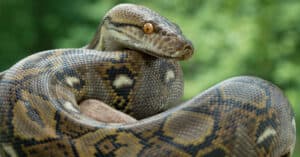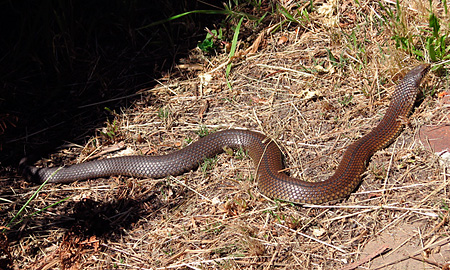Introduction
When it pertains to the interesting world of snakes, few types capture the creative imagination fairly like the baby tiger serpent. Known for their distinct pigmentation and powerful poison, these serpents are an integral component of Australia's one-of-a-kind environment. In this detailed write-up, we will certainly explore various facets of infant tiger snakes, including their habits, environment, and how to safely interact with them. Whether you're a wild animals enthusiast or simply interested about these animals, recognizing child tiger serpents can aid promote a much copperhead snake deeper recognition for nature.
Baby Tiger Snakes: What You Required to Know About Their Habits and Habitat
What Are Baby Tiger Snakes?
Baby tiger serpents are adolescent types of the very poisonous types recognized clinically as Notechis scutatus These snakes are mostly found in seaside areas of Australia, especially in Tasmania and southern Victoria. As they grow, their pigmentation modifications from a much more soft scheme to the particular yellow and black bands that give them their name.
One notable facet of infant tiger serpents is their size; hatchlings typically gauge around 25-30 cm in length. In spite of their little stature, they possess a shocking amount of poison that can be destructive to humans if bitten.

Physical Characteristics
Tiger snakes have a number of key physical attributes:
- Coloration: The distinctive banding pattern usually becomes much more noticable as they mature. Size: Adults can reach lengths of up to 2 meters. Body Shape: They have a robust body that helps in swimming and terrestrial movement.
Where Do Infant Tiger Snakes Live? Understanding Their Habitat
Understanding the environment preferences of baby tiger snakes is crucial for both conservation efforts and public safety and security. These serpents thrive in various atmospheres:
- Wetlands: Marshes and swamps provide enough searching grounds. Coastal Regions: Often found near coastlines where they can quest for prey. Woodlands: Dense greenery offers cover from predators.
Geographical Distribution
Tiger snakes are primarily found along Australia's southerly shoreline, including:
- Tasmania: Home to one of one of the most infamous populations. Victoria: Especially in locations near water bodies.
Are Tiger Snakes Venomous? A Deep Study Their Venom
One common concern occurs when discussing infant tiger serpents: "Are tiger serpents poisonous?" The solution is a resounding yes!

Venom Composition
The venom of tiger snakes has neurotoxins that can cause paralysis, coagulopathy (blood clotting concerns), and possibly fatality if without treatment. Right here's what you require to know:
- Effects on Humans: An attack from a tiger snake can bring about signs like swelling, pain at the bite website, queasiness, and also respiratory failure.
Comparison with Other Poisonous Snakes
In comparison to various other Australian serpents such as the eastern brown serpent or king brown snake, tiger serpent poison is thought about amongst the most powerful. Nonetheless, fatalities are uncommon due to enhanced medical therapies and accessibility to antivenom.
Behavioral Patterns of Infant Tiger Snakes
Understanding exactly how infant tiger snakes act is important for those that live in or visit locations where these reptiles are prevalent.
Nocturnal Habits
Most infant tiger serpents show nocturnal habits. They Check out the post right here tend to forage for food during cooler evening temperatures. This versatility aids them avoid killers while enhancing their hunting efficiency.
Hunting Techniques
Their searching methods include:
- Ambush Predation: Waiting inactive up until target comes close. Active Foraging: Proactively moving through plant life or along rivers looking for food.
First Help for Snake Bites: What You Should Know
Despite being remarkable creatures, encounters with child tiger snakes can bring about unsafe situations if attacks happen. Recognizing emergency treatment procedures can save lives.
Immediate Tips After a Bite
Remain calm; panic raises heart rate. Immobilize the affected limb making use of a splint or bandage. Seek immediate clinical focus-- antivenom might be necessary.Creating a Snake Bite First Aid Kit
A well-prepared emergency treatment kit should include:
|Item|Purpose|| ------------------------------|--------------------------------------|| Compression plaster|To incapacitate the limb|| Splint|Stabilizes broken bones or joints|| Antihistamines|Eases allergic reactions|| Emergency situation contact numbers|Quick accessibility throughout emergencies|
Common Myths About Tiger Snakes Debunked
Many myths surround these intriguing reptiles; let's clear up some false impressions frequently held by people.
Myth # 1: All Tiger Snakes Are Aggressive
While some people might exhibit defensive what are the most venomous snakes in australia habits when endangered, not all tiger snakes display screen aggressiveness in the direction of people unless provoked.
Myth # 2: Child Tiger Snakes Are Less Dangerous Than Adults
This misconception can not be further from the truth! Child tiger snakes consist of almost as much venom as adults relative to their size; thus they posture substantial dangers if bitten.
FAQs Regarding Child Tiger Snakes
What do infant tiger snakes eat?- They mostly consume tiny animals, birds, frogs, and fish.
- Look for slender bodies with faint banding patterns that come to be a lot more pronounced as they mature.
- Yes! Birds of prey and larger reptiles might target them.
- Typically every couple of weeks as they proliferate during their very early life stages.
- While some individuals do keep them illegally without authorizations because of their dangerous nature; it's normally not suggested given their venomous status.
- With punctual clinical treatment-- including antivenom-- the survival price is high!
Conclusion
In summary, recognizing baby tiger serpents-- what they consume, where they live, just how they act-- can equip us with valuable knowledge regarding these impressive yet unsafe creatures. The importance of education surrounding first aid actions can not be overstated; understanding exactly how to react efficiently after a bite can save lives while fostering regard for our slinking next-door neighbors within Australia's abundant biodiversity range.
By appreciating these snakes' functions within environments-- and recognizing potential risks-- we advertise conjunction rather than fear-based reactions toward one another's presence in nature's grand tapestry! Whether you're a serious hiker pondering your next experience or simply curious regarding local wildlife encounters near home-- this guide functions as your trusted reference point on the enigmatic globe inhabited by our buddies-- the stunning baby tiger snake!